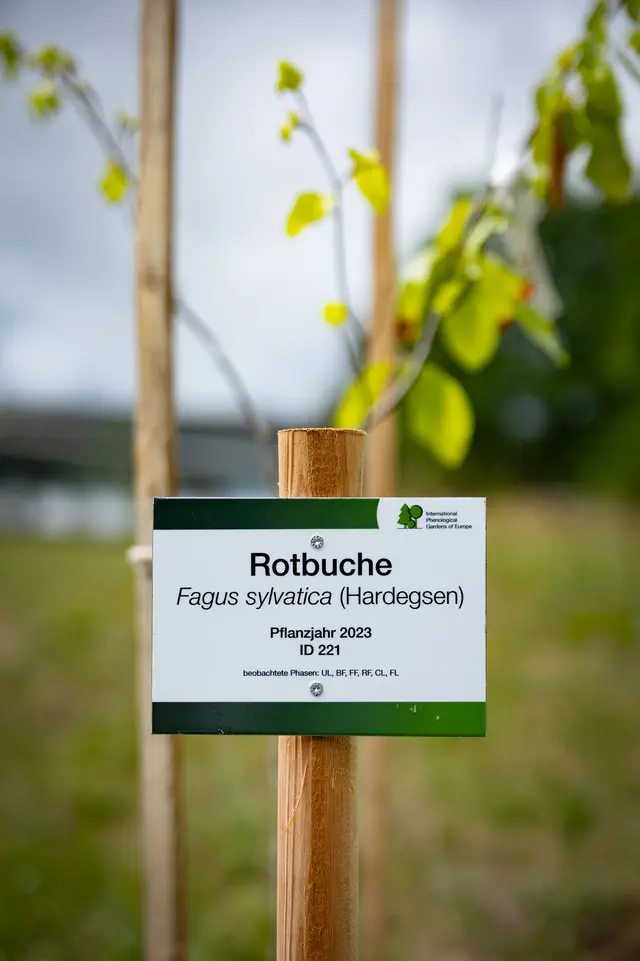New phenological garden on KU’s Eichstätt campus

The small plates on the tree seedlings say bird cherry, copper beech, littleleaf linden or Scots pine. They are still small plants with few side shoots that now grow in the green space around the KU Main Library. The seedlings – especially of tree species that are important for forest ecosystems in this country – all come from the Grafrath Forest Experience Center of the Fürstenfeldbruck Office of Food, Agriculture and Forestry. The basic principle of the International Phenological Gardens is that genetically identical trees and shrubs are planted at different locations across Europe, and their development is subsequently monitored in a standardized manner. Because the plants all go back to a single mother plant, genetic variability can be largely ruled out, explains KU geographer Prof. Dr. Susanne Jochner-Oette. Therefore, scientists let two cuttings of the same plant bloom at the same time in different places under the same climatic conditions, explains the professor of physical geography, landscape ecology and sustainable ecosystem development, using the example of two forsythia cuttings from the garden of the mother plant in Grafrath, which she presented to KU President Prof. Dr. Gabriele Gien and the deputy mayor of Eichstätt, Elisabeth Gabler-Hofrichter, at the opening of the phenological garden. In this way, says Jochner-Oette, scientists can draw even more precise conclusions regarding the influence of environmental factors and the response of ecosystems to them.
The idea of phenological gardens originated as early as 1953 in the Commission for Agricultural Meteorology of the World Meteorological Organization. That was also the time when the ‘mother garden’ was established. The network of gardens has since grown across Europe – and with it the amount of data collected from the gardens: the times when the first leaves become visible on the plants in spring, when they begin to flower, bear ripe fruit, or when the leaves change color in autumn and finally begin to fall off. From now on, these observation data will also be collected in Eichstätt and processed in a database, which was developed and is operated by the University Library. This year, the scientific management and coordination of the network of International Phenological Gardens has been taken over by Professor Jochner-Oette together with her colleague Johanna Jetschni. Previously, Prof. Dr. Frank Chmielewski from the Institute of Agricultural and Horticultural Sciences at Humboldt University Berlin had headed the network for more than 25 years. At the opening of the garden in Eichstätt, he expressed his gratitude that the coordination was now in good hands in Eichstätt and that the scientific work would thus be continued.
The observations in the phenological gardens make an important contribution to sustainability research and are therefore an ideal match with the KU's scientific focus, said the University's President, Gabriele Gien. "In addition, the Europe-wide project also increases the international visibility and networking of our research activities further", said Jochner-Oette when she explained the contribution that phenological observations make to understanding how ecosystems respond to environmental change. Phenology has an important indicator function when it comes to detecting environmental changes and to determining and understanding the consequences of changing temperatures, precipitation amounts or sunshine durations.
It is not just about documenting visually perceptible changes in nature. The data could also be used to make climate model calculations more precise. Plant development itself also has an impact on our climate, says Jochner-Oette. Evaporation through the leaves changes air temperature and humidity. Dense tree canopies keep solar radiation away from the earth's surface and thus influence the microclimate on the ground. In addition, there are biochemical material cycles between plants and the atmosphere, for example with regard to the cycle of carbon dioxide. And the timing of when a plant begins to bloom in turn affects the behavior of insects that feed on the nectar. In her research, Jochner-Oette also focuses on the consequences for humans – for example, with regard to those suffering from allergies who have a difficult time during pollination. In other projects, the Eichstätt Geography department has been investigating for some time how these factors can be predicted better – the data from the phenological gardens are also helpful in this context.
![[Translate to Englisch:] Eröffnung des Phänologischen Gartens in Eichstätt: von links Sven John, stellvertretender Eichstätter Landrat, die zweite Bürgermeisterin Elisabeth Gabler-Hofrichter, Johanna Jetschni und Professorin Susanne Jochner-Oette vom Fachbereich Geographie, KU-Präsidentin Prof. Dr. Gabriele Gien sowie Prof. Dr. Frank Chmielewski von der Humboldt Universität Berlin.](/fileadmin/_processed_/7/6/csm_Eroeffnung_IPG1_d55217ed0f.webp)